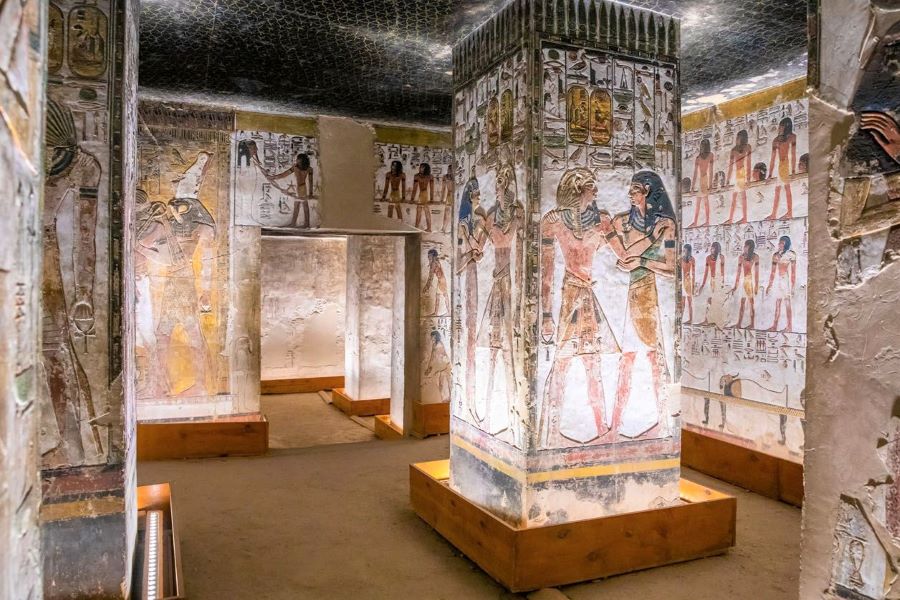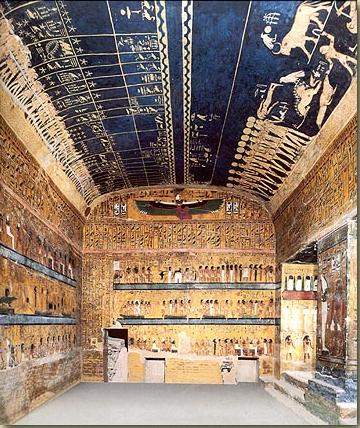The tomb of Pharaoh Seti I, located in the Valley of the Kings, is one of the grandest and most elaborately decorated tombs ever discovered. Seti I, the father of Ramses II and a powerful ruler of the 19th Dynasty, was honored in death with a final resting place that reflected both his earthly achievements and the Egyptian concept of the afterlife. Among the remarkable features of his tomb is the astronomical ceiling in his burial chamber—a masterpiece of ancient Egyptian art and celestial knowledge.
1. The Discovery of Seti I’s Tomb
The tomb of Seti I was discovered in 1817 by Italian archaeologist Giovanni Belzoni. Unlike many other tombs in the Valley of the Kings, Seti’s tomb is vast and filled with detailed decorations and inscriptions. Its walls and ceilings display complex and symbolic imagery, including scenes from the Book of the Dead and the Book of Gates, which depict Seti’s journey through the afterlife. However, what sets this tomb apart is the astronomical ceiling in the burial chamber, which provides unique insights into ancient Egyptian cosmology.

2. The Astronomical Ceiling: A Map of the Heavens
The burial chamber’s ceiling is adorned with an astonishing representation of the heavens. This ceiling shows constellations and celestial symbols carefully painted to depict Egypt’s understanding of the cosmos. Ancient Egyptians placed great significance on stars and celestial bodies, associating them with gods, protection, and eternal life.
The constellations on the ceiling are shaped like animals—crocodiles, bulls, and lions. These symbols, representing circumpolar constellations, were chosen for their powerful meanings. In Egyptian belief, circumpolar stars (those that never set) represented eternity, as they circled perpetually around the celestial north pole. By surrounding Seti I’s burial place with these symbols, the tomb artisans created a symbolic barrier of eternal stars to protect him in the afterlife.
3. Analysis of Celestial Symbols: Crocodile, Bull, and Lion
Each constellation painted on Seti I’s ceiling holds distinct meaning within Egyptian culture:
- The Crocodile: In Egyptian mythology, crocodiles were linked to the god Sobek, a powerful deity associated with strength, fertility, and protection. The crocodile constellation symbolized both physical and spiritual strength, guarding Seti’s tomb against harmful forces.
- The Bull: The bull symbolized the god Apis and was a powerful icon of strength, fertility, and kingship. The bull constellation was a reminder of Seti’s royal power and his enduring strength as a pharaoh.
- The Lion: Lions were associated with the goddess Sekhmet, who represented war, healing, and divine protection. As a constellation, the lion was a fierce guardian of the pharaoh’s soul, warding off threats in the journey through the afterlife.
These celestial symbols were more than decorative—they were designed to guide Seti I through the realms of the dead and protect him for eternity. Each constellation was carefully chosen to provide specific forms of spiritual guidance and protection, underscoring how seriously Egyptians viewed the role of the stars in the afterlife.

4. Ancient Egyptian Cosmology: The Connection Between Pharaohs and Stars
In ancient Egyptian culture, the pharaoh was seen as a divine being, a representative of the gods on earth who would continue to serve them in the afterlife. Egyptians believed that after death, the pharaoh would ascend to the heavens and become one with the stars, particularly the imperishable circumpolar stars that never set. The stars on the ceiling of Seti I’s tomb symbolized this belief and represented the pharaoh’s connection to eternity.
Moreover, Egyptian burial practices often included careful mapping of the night sky, believing that the stars could guide the soul safely to the afterlife. By covering Seti I’s ceiling with these celestial symbols, the Egyptians ensured that he would never lose his way in the afterlife and would be eternally connected to the heavens.

5. The Legacy of the Tomb’s Astronomical Ceiling
The astronomical ceiling in Seti I’s tomb stands as a stunning testament to the sophistication of ancient Egyptian astronomy and religious beliefs. Its discovery not only provided insights into how Egyptians viewed the heavens but also gave modern archaeologists a deeper understanding of their intricate burial customs. The symbols on the ceiling serve as an enduring reminder of Seti I’s divine status and the Egyptians’ unwavering belief in an eternal afterlife.
Through this ceiling, we gain a profound glimpse into the mysteries of the cosmos as understood by one of the world’s oldest civilizations. The tomb of Seti I remains an invaluable archaeological site, shedding light on how ancient Egyptians perceived the universe and their place within it. This celestial art and symbolism continue to captivate historians and visitors alike, offering a timeless link to the spiritual and astronomical knowledge of ancient Egypt.

